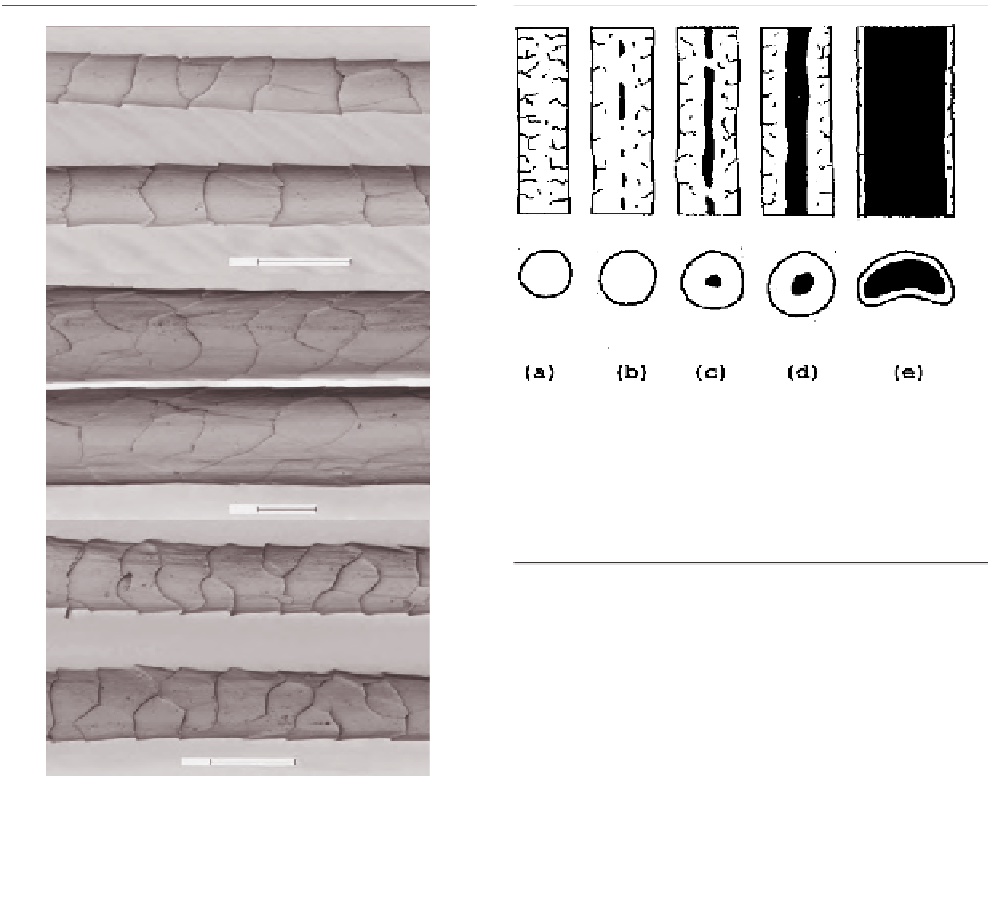Agriculture Reference
In-Depth Information
Chinese Cashmere Fibers
DWI: Phan/Wortmann
20.0
μ
m
Figure 15.5
Idealized projection microscope
images of longitudinal sections of medullated
mohair fi bers. a) non-medullated, b) fragmented
med fi ber, c) interrupted med fi ber,
d) continuous med fi ber, e) continuous kemp
fi ber.
Mohair Fibers
DWI: Phan/Wortmann
20.0
μ
m
industry. However, all medullated fi bers in mohair appear
to belong to a continuous population (Lupton et al., 1991).
The important implication for the selection practices of
breeders is that both types of medullated fi bers should be
selected against.
Cashmere
Dehaired cashmere is characterized by its softness to the
touch and the lightness and excellent thermal properties of
fabrics composed of cashmere down. Microscopically,
cashmere fi bers appear to be very similar to very fi ne
Merino wool with one or two scales encircling the fi ber
and six to seven scale margins per 100 μ m (Figure 15.4 ).
Distinct longitudinal striations are visible in the cuticle
layer of white and pastel fi bers. No medullation is present
except for the continuous medulla in the few guard hair
fi bers that typically contaminate a dehaired cashmere
sample and which are multiple times coarser than the fi ne
down fi bers. The scales on the guard hair form an irregular
waved mosaic pattern with margins being close together
and smooth or slightly rippled.
Merino Wool Fibers
DWI: Phan/Wortmann
20.0
μ
m
Figure 15.4
Composite scanning electron
micrograph of mohair, cashmere, and wool
fi bers (courtesy of International Wool Textile
Organization).
length and extend to more than 60% of the width of the
fi ber. This much medullation produces an optical effect
that causes the fi bers to have a different appearance com-
pared to unmedullated, solid fi bers (that is, a chalky versus
normal lustrous appearance) that becomes even more pro-
nounced when the fi bers are dyed to dark shades. The
medulla itself is composed of a hollow network of cell
walls. Kemp fi bers are typically oval in cross section,
coarser (1.8 times) than the parent population and occur as
short, straight, shedded fi bers as well as full-length attached
fi bers. Fibers with medullation less than 60% of the fi ber
diameter, both continuous and interrupted, cannot usually
be distinguished from normal solid fi bers with the naked
eye and are not usually discriminated against by the textile
OBJECTIVE MEASUREMENTS AND
SUBJECTIVE ESTIMATES OF FIBER
AND FLEECE
Fiber and fl eece properties are used, with varying degrees
of accuracy, to predict textile processing performance and






